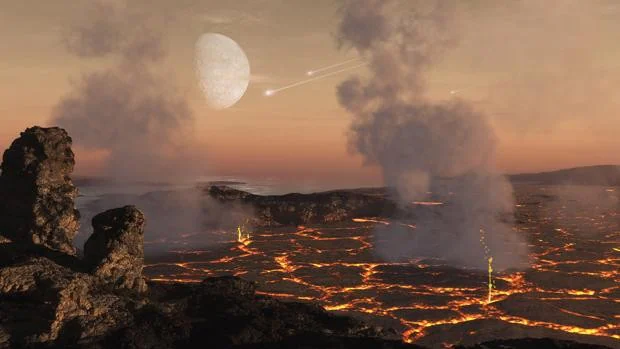 During the formation of rocky planets, when the planetary building blocks fuse under extreme heat and intense volcanism, gases are released. If the planet is large enough, these gases will be trapped, forming its atmosphere. To simulate this process, a team from the University of California, Santa Cruz, has devised a new method: "baking" meteorites that have reached Earth at over 1,000 degrees Celsius to understand what can happen in those early moments of planetary formation. The results have just been published in the journal Nature Astronomy.
During the formation of rocky planets, when the planetary building blocks fuse under extreme heat and intense volcanism, gases are released. If the planet is large enough, these gases will be trapped, forming its atmosphere. To simulate this process, a team from the University of California, Santa Cruz, has devised a new method: "baking" meteorites that have reached Earth at over 1,000 degrees Celsius to understand what can happen in those early moments of planetary formation. The results have just been published in the journal Nature Astronomy.
"This information will be very important when we begin observing exoplanet atmospheres with new telescopes and advanced instrumentation," says Maggie Thompson, a graduate student in astronomy and astrophysics at UC Santa Cruz and lead author of the paper. "We're trying to simulate this very early process in the laboratory, when a planet's atmosphere is forming, so we can put some experimental constraints on it," explains Myriam Telus, assistant professor of Earth and planetary sciences and co-author of the study.
The team "baked" three specific meteorites: the Murchison chondrite, which fell in Australia in 1969; the Jbilet Winselwan chondrite, collected in Western Sahara in 2013; and the Aguas Zarcas chondrite, which fell in Costa Rica in 2019. All of these rocks are carbonaceous chondrites, with a composition very similar to the material from which the Sun and the planets in our cosmic neighborhood formed. "These meteorites are leftover materials from the building blocks that made the planets in our Solar System. Chondrites are different from other types of meteorites in that they didn't get hot enough to melt, so some more primitive components survive that can tell us about the composition of the Solar System at the time of planet formation," Thompson notes.
In the degassing experiments, samples from three carbonaceous chondrite meteorites were analyzed: Murchison, Jbilet Winselwan, and Aguas Zarcas.
–
M. Thompson
The experiment
To analyze them, the researchers set up a furnace connected to a mass spectrometer and a vacuum system. As the meteorite samples were heated to 1,200 degrees Celsius, the system analyzed the volatile gases produced by the minerals in the sample. The largest amount was water vapor, followed by carbon monoxide and carbon dioxide. Smaller amounts of hydrogen and hydrogen sulfide gases were also released.
According to Telus, planetary atmosphere models often assume that they resemble those of their star, dominated by hydrogen and helium—or solar abundance. However, the fact that water vapor was the dominant gas, followed by carbon monoxide and carbon dioxide, indicates that this is not always the case and that atmospheres form differently depending on whether the planet is gaseous or rocky. "Using solar abundance is fine for large planets, the size of Jupiter, which acquire their atmospheres from the solar nebula. But smaller planets are thought to obtain their atmospheres mostly from outgassing," the researcher points out.
These results are consistent with chemical equilibrium models based on meteorite composition. "Although there are some differences," Thompson notes. "Experiments are needed to see what actually happens in practice, so the next step will be to analyze more meteorites to better constrain theoretical models of exoplanetary atmospheres."
Finally, the researchers state that although meteorites from our Solar System are being used to catalog the atmospheres of other star systems, other studies indicate that carbonaceous chondrites are quite common in other cosmic neighborhoods. "It may seem arbitrary to use meteorites from our Solar System to understand exoplanets around other stars, but studies of other stars are finding that this type of material is quite common around other stars."
